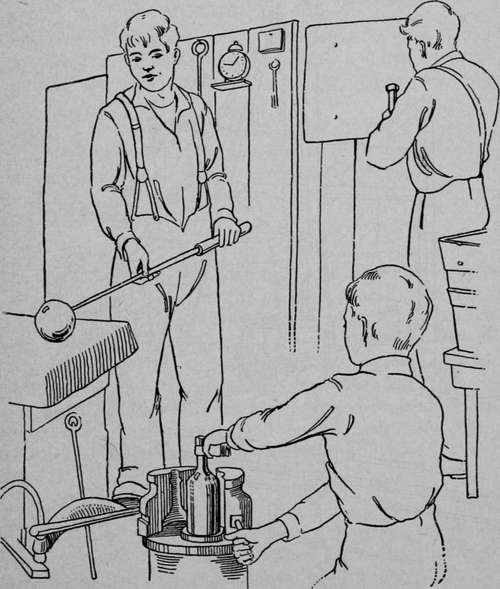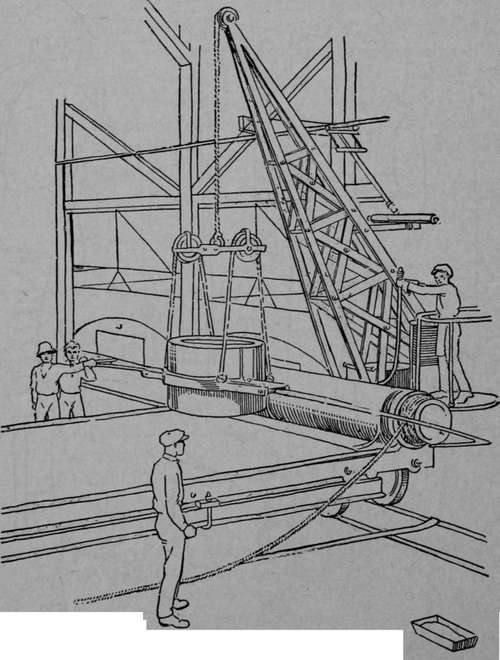How Are Things Made Of Glass ?
Description
This section is from the book "Experimental Glass Blowing For Boys", by Carleton J. Lynde. Also available from Amazon: Experimental Glass Blowing for Boys.
How Are Things Made Of Glass ?
The glass mixture is heated to a high temperature in fire clay-pots or tanks in large ovens. The surface is skimmed from time to time and the heating is continued until all air bubbles have escaped from the mixture, usually about three days.
The glass is now quite fluid and it is allowed to cool somewhat until it is viscous; then the objects are made by blowing, pressing, or rolling, as described below.
The finished articles are finally "annealed," that is, they are placed while still hot in a second hot oven, which is then sealed and allowed to cool slowly, for four or five days or for as many weeks, according to the kind of glass.
If a glass object cools quickly, it cools more rapidly on the surface than in the interior. This produces a condition of strain in the glass and the object may drop to pieces when jarred or scratched. This condition of strain is avoided by allowing the objects to cool very slowly, that is, by annealing.
Window Glass
Window glass is blown in exactly the same way as you have blown glass balloons; the process is illustrated in Fig. 1.
The glass mixture is heated for about three days in fire clay pots and is allowed to cool until it is viscous. The glass blower then attaches a lump of the viscous glass to the end of a straight iron blowpipe about five feet long and blows a bulb. He then reheats the glass and blows a larger pear-shaped bulb and in doing so rests the glass on a pear-shaped mold of charred wood (see center of Fig. 1). He again reheats the glass, holds the pear-shaped bulb overapit,and blows a longcylinder(see left of Fig. 1).
The ends of the cylinder are now cut off and the edges are smeared with molten glass to prevent splitting (see right, Fig. 21). The cylinder is next cut lengthwise with a diamond (center, Fig. 21), and is placed in a second hot oven, where it is ironed out flat (Fig. 22).
The flat sheets are finally annealed in a third oven for a number of days and are then cut into panes, sorted, and packed.

Bottles Blown In A Mold
Glass Tubes
The glass tubes with which you do the experiments in this book are made in the same way as window glass up to the stage of blowing the cylinder; then the blower's helper attaches an iron rod to the opposite end of the cylinder (see right of Fig. 1), and the blower and helper walk backward away from each other to pull the cylinder into a tube. Of course, they use a small amount of glass to make small tubes, and larger amounts for large tubes.

Fig. 24. Rolling Plate Glass
Molded Glass
Many articles of glass are made by blowing the glass in molds. Bottles are made in this way (Fig. 23), and large machines are now in use which mold many bottles at one time in this way.
Pressed Glass
Many articles are made by pressing glass into molds, that is. the molten glass is poured into molds and is pressed against the sides of the mold by means of a plunger. Imitation cut glass is pressed in this way.
Plate Glass
The large sheets of plate glass used in store windows are not blown, but rolled. The molten glass is poured from the fire clay pots upon a cast-iron table and is rolled flat by means of a large iron roller (Fig. 24). The glass is then in the shape of plate glass, but is rough on both sides. It is annealed for a number of days and then is ground smooth on both sides, first with coarse emery, then with finer and finer emery, and is finally polished with rouge. The result is the beautifully polished plate glass we see in large windows.
Optical Glass
The United States and Great Britain made great strides in the manufacture of optical glass during the war and there are now many kinds on the market. They are used in making the lenses, prisms, and mirrors for optical instruments.
Optical glass is made in much the same way as ordinary glass, but great care is taken: first, to see that the materials are pure; second, to stir the glass constantly, as it cools from the molten to the viscous state, to make it as uniform as possible; and third, to cool it very slowly in the annealing process, to avoid strains.
Quartz Glass
An entirely new glass has been placed on the market in quantity in recent years. It is made by melting very pure quartz sand at a temperature of 3000° F. and cooling it fairly rapidly. It has the very valuable property of expanding and contracting very, very slightly when heated and cooled. Thus there is practically no internal strain set up when it is heated or cooled quickly and it does not break. It can be heated red hot, for example, and then plunged into cold water without breaking. It is probable that this glass will be in universal use in a very few years.
Continue to:
